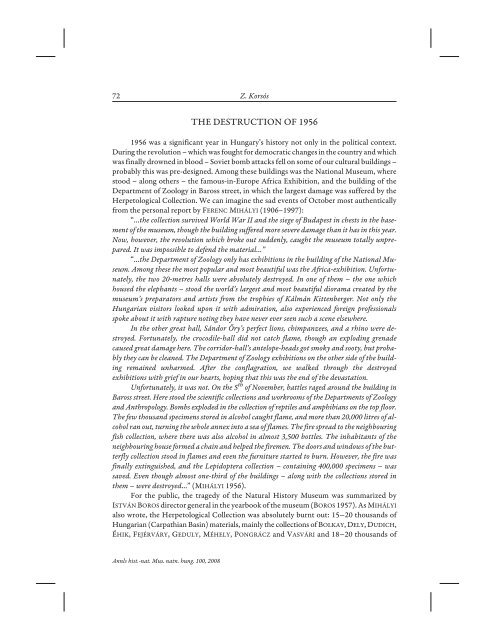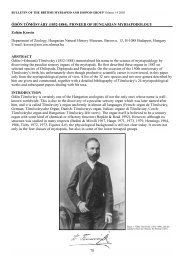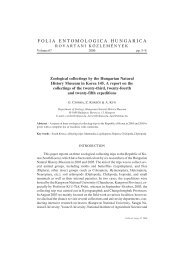History of the Herpetological Collection of the ... - Korsós Zoltán
History of the Herpetological Collection of the ... - Korsós Zoltán
History of the Herpetological Collection of the ... - Korsós Zoltán
You also want an ePaper? Increase the reach of your titles
YUMPU automatically turns print PDFs into web optimized ePapers that Google loves.
72 Z. Korsós<br />
THE DESTRUCTION OF 1956<br />
1956 was a significant year in Hungary’s history not only in <strong>the</strong> political context.<br />
During <strong>the</strong> revolution – which was fought for democratic changes in <strong>the</strong> country and which<br />
was finally drowned in blood – Soviet bomb attacks fell on some <strong>of</strong> our cultural buildings –<br />
probably this was pre-designed. Among <strong>the</strong>se buildings was <strong>the</strong> National Museum, where<br />
stood – along o<strong>the</strong>rs – <strong>the</strong> famous-in-Europe Africa Exhibition, and <strong>the</strong> building <strong>of</strong> <strong>the</strong><br />
Department <strong>of</strong> Zoology in Baross street, in which <strong>the</strong> largest damage was suffered by <strong>the</strong><br />
<strong>Herpetological</strong> <strong>Collection</strong>. We can imagine <strong>the</strong> sad events <strong>of</strong> October most au<strong>the</strong>ntically<br />
from <strong>the</strong> personal report by FERENC MIHÁLYI (1906–1997):<br />
“…<strong>the</strong> collection survived World War II and <strong>the</strong> siege <strong>of</strong> Budapest in chests in <strong>the</strong> basement<br />
<strong>of</strong> <strong>the</strong> museum, though <strong>the</strong> building suffered more severe damage than it has in this year.<br />
Now, however, <strong>the</strong> revolution which broke out suddenly, caught <strong>the</strong> museum totally unprepared.<br />
It was impossible to defend <strong>the</strong> material…”<br />
“…<strong>the</strong> Department <strong>of</strong> Zoology only has exhibitions in <strong>the</strong> building <strong>of</strong> <strong>the</strong> National Museum.<br />
Among <strong>the</strong>se <strong>the</strong> most popular and most beautiful was <strong>the</strong> Africa-exhibition. Unfortunately,<br />
<strong>the</strong> two 20-metres halls were absolutely destroyed. In one <strong>of</strong> <strong>the</strong>m – <strong>the</strong> one which<br />
housed <strong>the</strong> elephants – stood <strong>the</strong> world’s largest and most beautiful diorama created by <strong>the</strong><br />
museum’s preparators and artists from <strong>the</strong> trophies <strong>of</strong> Kálmán Kittenberger. Not only <strong>the</strong><br />
Hungarian visitors looked upon it with admiration, also experienced foreign pr<strong>of</strong>essionals<br />
spoke about it with rapture noting <strong>the</strong>y have never ever seen such a scene elsewhere.<br />
In <strong>the</strong> o<strong>the</strong>r great hall, Sándor Õry’s perfect lions, chimpanzees, and a rhino were destroyed.<br />
Fortunately, <strong>the</strong> crocodile-hall did not catch flame, though an exploding grenade<br />
caused great damage here. The corridor-hall’s antelope-heads got smoky and sooty, but probably<br />
<strong>the</strong>y can be cleaned. The Department <strong>of</strong> Zoology exhibitions on <strong>the</strong> o<strong>the</strong>r side <strong>of</strong> <strong>the</strong> building<br />
remained unharmed. After <strong>the</strong> conflagration, we walked through <strong>the</strong> destroyed<br />
exhibitions with grief in our hearts, hoping that this was <strong>the</strong> end <strong>of</strong> <strong>the</strong> devastation.<br />
Unfortunately, it was not. On <strong>the</strong> 5 th <strong>of</strong> November, battles raged around <strong>the</strong> building in<br />
Baross street. Here stood <strong>the</strong> scientific collections and workrooms <strong>of</strong> <strong>the</strong> Departments <strong>of</strong> Zoology<br />
and Anthropology. Bombs exploded in <strong>the</strong> collection <strong>of</strong> reptiles and amphibians on <strong>the</strong> top floor.<br />
The few thousand specimens stored in alcohol caught flame, and more than 20,000 litres <strong>of</strong> alcohol<br />
ran out, turning <strong>the</strong> whole annex into a sea <strong>of</strong> flames. The fire spread to <strong>the</strong> neighbouring<br />
fish collection, where <strong>the</strong>re was also alcohol in almost 3,500 bottles. The inhabitants <strong>of</strong> <strong>the</strong><br />
neighbouring house formed a chain and helped <strong>the</strong> firemen. The doors and windows <strong>of</strong> <strong>the</strong> butterfly<br />
collection stood in flames and even <strong>the</strong> furniture started to burn. However, <strong>the</strong> fire was<br />
finally extinguished, and <strong>the</strong> Lepidoptera collection – containing 400,000 specimens – was<br />
saved. Even though almost one-third <strong>of</strong> <strong>the</strong> buildings – along with <strong>the</strong> collections stored in<br />
<strong>the</strong>m – were destroyed…” (MIHÁLYI 1956).<br />
For <strong>the</strong> public, <strong>the</strong> tragedy <strong>of</strong> <strong>the</strong> Natural <strong>History</strong> Museum was summarized by<br />
ISTVÁN BOROS director general in <strong>the</strong> yearbook <strong>of</strong> <strong>the</strong> museum (BOROS 1957). As MIHÁLYI<br />
also wrote, <strong>the</strong> <strong>Herpetological</strong> <strong>Collection</strong> was absolutely burnt out: 15−20 thousands <strong>of</strong><br />
Hungarian (Carpathian Basin) materials, mainly <strong>the</strong> collections <strong>of</strong> BOLKAY,DELY,DUDICH,<br />
ÉHIK, FEJÉRVÁRY, GEDULY, MÉHELY, PONGRÁCZ and VASVÁRI and 18−20 thousands <strong>of</strong><br />
Annls hist.-nat. Mus. natn. hung. 100, 2008




